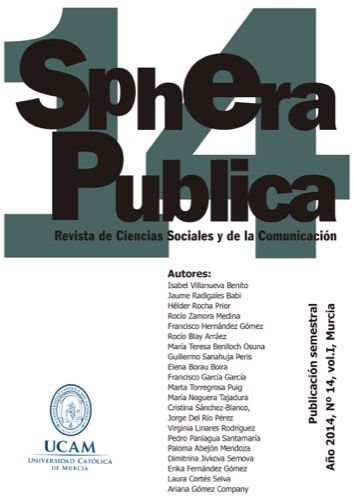How new media are changing opera: the opera singers’ social image transformed by cinema and audio-visual media
Palabras clave:
Mediatization, Performing Arts, Opera, Communication, CultureResumen
Immersed today in a complex process of building customer loyalty and attracting new audiences, the opera industry is using media to expand its horizons beyond theatres. And what makes this possible is opera's visual nature and its universal language. Opera can be seen in various formats: opera in theatres, filmed operas, lyrical video clips, opera on TV, cyber opera etc. Set against the constant audio-visual interventionism and the new demands of consumers who are increasingly reliant on the media, it is necessary to reflect on the profound aesthetic and artistic transformation of the figure of the opera singer.
Considering historical, sociological and artistic perspectives, this paper analyses the new face of the celebrated opera singers offered by the media, in order to clarify some questions: How have the media historically conceived the figure of the opera singer? What changes might the opera singer’s image have suffered after the audio-visual boom of the digital age? What transformations is the opera star system going through today driven by consumption of new media?
Citas
Adorno, T. (2006). Escritos musicales I-III. Madrid: Ediciones Akal.
Atkinson, P. (2006). Opera and the Embodiment of Performance. En D. Waskul & P. Vannini (Eds). Body/embodiment. Symbolic interaction and the sociology of the body (pp. 95-108). Hampshire: Ashgate Publishing Company.
Auden, W. H. (1951). Some Reflections on Opera as a Medium. Tempo, New Series, 20, 6-10.
Balázs, B. (1978). Formas artísticas musicales. En B. Balázs. El film. Evolución y esencia de un arte nuevo (pp. 230-234). Barcelona: Editorial Gustavo Gili.
Barba, D. (2010, mayo, 19). No soy un provocador: la transgresión es lo mío. Entrevista a Gerard Mortier. La Vanguardia, 24-25.
Barnes, J. (2003). Television Opera: The fall of Opera commissioned for Television. Woodbridge: The Boybell Press.
Batta, A. (2005). Opera: compositores, obras, intérpretes. Barcelona: Tandem Verlag GmbH
Bazin, A. (2006). ¿Qué es el cine?. Madrid: Ediciones Rialp.
Bingham, D. (2010). Whose Lives Are They Anyway? The Biopic as Contemporary Film Genre. Bedfordshire: Rutgers University Press
Benjamin, W. (1989). La obra de arte en la época de su reproductibilidad técnica. En W. Benjamin, Discursos interrumpidos I. Buenos Aires: Taurus.
Berini, B. (2011). Entrevista realizada por los autores al departamento audiovisual y de documentación del Gran Teatre del Liceu. Barcelona.
Bordwell, D. & Thompson, K. (1993). El arte cinematográfico. Barcelona: Paidós Ibérica.
Bourre, J. (1987). Opéra et Cinema. París: Artefact.
Bové, X. (2011). Entrevista realizada por los autores al departamento audiovisual y de documentación del Gran Teatre del Liceu. Barcelona.
Burch, N. (1987). El tragaluz del infinito. Madrid: Ediciones Cátedra.
Bustamante, E. (2011). Cultura digital: la "nueva" cultura clásica. Telos, 88. From http://sociedadinformacion.fundacion.telefonica.com/seccion=1268&idioma=es_ES&id=2011072709090001&activo=6.do
Carroll, J; Foth, M. & Adkins, B. (2010). Traversing urban social spaces: how online research helps unveil offline practice. En J. Hunsinger; L. Klastrup, & M. Allen. International handbook of Internet research (pp. 147 €“158). New York: Springer Netherlands.
Christiansen, R. (1984). Prima Donna: A History. New York: Penguin Books.
Citron, M. (1994). Subjectivity in the Opera Films of Jean-Pierre Ponnelle. The Journal of Musicology, 22 (2), 203 €“240.
Citron, M. (2000). Opera on Screen. London: Yale University Press.
Cuadrado, M. (2001). La gestión de marketing en las entidades escénicas. Una evidencia empírica. DYO, 25, 80 €“87.
D’Agostino, P. (2010). The digital stage. Opera production for cinema and other audiovisual formats, a conversation with. International Workshop on Opera and Video. Valencia: Universidad Politécnica de Valencia/ Institut Valencià de la Música.
Dahlhaus, C. (1988). Drammaturgia dell ´opera italiana. Torino: EDT.
De Diego, A. (2010). Nuevas estrategias comunicativas en ópera por la inclusión del "making of" en los DVDs. International Workshop on Opera y Video. Valencia: Universidad Politécnica de Valencia/ Institut Valencià de la Música. From http://us.academia.edu/AntonioDeDiego/Talks/34447/_New_Communication_Strategies_at_Opera_by_the_inclusion_of_Making_of_in_DVDs_
Donington, R. (1988). Close Ups v. Opera. The Musical Times, 129, 281.
Eco, U. (1985). Obra abierta. Barcelona: Planeta-De Agostini.
Fawkes, R. (2000). Opera on Film. London: Gerald Duckworth & Co.
Fontcuberta, M. (2003). Medios de comunicación y gestión del conocimiento. Revista Iberoamericana de Educación, 32. From http://www.rieoei.org/rie32a05.htm
Fülfe, R. (2011). Kulturmarketing: Impulse für eine zielgrup- pengerechte Ansprache im Bereich E-Musik. Hamburg: Diplomica Verlag.
García Avilés, J. (2009). La comunicación ante la convergencia digital. Signo y Pensamiento, 54, 102-113.
Gombrich, E. H. (1995). La historia del Arte. Madrid: Phaidon Press.
Gordillo, I. (2008). La hibridación en las nuevas formas dramáticas y espectaculares del siglo XXI. Icono14 (10), 1-20.
Heyer, P. (2008). Live from the Met: Digital Broadcast Cinema, Medium Theory, and Opera for the Masses. Canadian Journal of Communication, 33, 591-604.
Ishaghpour, Y. (1995). Opéra et théâtre dans le cinéma d ´aujourd ´hui. París: La Différence.
Jenkins, H. (2008). Convergence culture: La cultura de la convergencia de los medios de comunicación. Barcelona: Paidós.
Lacasa, I. & Villanueva, I. (2011). La digitalización audiovisual de la ópera. Nuevos medios, nuevos usos, nuevos públicos. Telos, 88, 65-74.
Lacasa, I. & Villanueva, I. (2012). Actualización de la ópera y sus nuevos modelos de comunicación digital. El Profesional de la Información, 21 (4), 413-418.
Laenen, A. (2003). Why Opera Education?: a RESEO research report. Antwerp: RESEO.
Lipovetsky, G. & Serroy, J. (2009). La pantalla global. Cultura mediática y cine en la era hipermoderna. Barcelona: Anagrama.
Lundby, K. (2009). Mediatization: concept, changes, consequences. New York: Peter Lang Publishing.
Martel, F. (2011). Cultura "mainstream": cómo nacen los fenómenos de masas. Madrid: Taurus.
Matellanes J.C. (2007). Globalización de un arte global: la ópera. Boletín de Estudios Económicos, LXII, 92, 151-155.
Miège, B. (2006). La concentración en las industrias culturales y mediáticas (ICM) y los cambios en los contenidos. Cuadernos de Información y Comunicación, 11, 155-166.
Moreno-Cámara, A. & Prieto-Gutiérrez, J. (2011). Instituciones culturales en un click. Razón y palabra, 78. Recuperado de: http://www.razonypalabra.org.mx/varia/N78/2a parte/25_ MorenoPrieto_V78.pdf
Morris, C. (2010). Digital Diva: Opera on video. Opera Quarterly, 26 (1), 96-119. doi:10.1093/oq/kbq002
Parker, R. (1998). Historia ilustrada de la ópera. Barcelona: Paidós Ibérica.
Pereira-Domínguez, C. & Urpí-Guercia, C. (2005). Cine y juventud: una propuesta educativa integral. Revista de estudios de juventud, 68, 73-89.
Powrie, P., Babington, B. Davies, A. & Perrian, C. (2007). Carmen on Film. A Cultural History, Bloomington & Indianapolis: Indiana University Press.
Radigales, J. (1999). L ´Ã’pera. Música, teatre i espectacle. Barcelona: Enciclopedia Catalana.
Radigales, J. (2005). La ópera y el cine: afinidades electivas. En M. Olarte (Ed.), La música en los medios audiovisuales (pp. 59-84). Salamanca: Universitaria.
Radigales, J. & Fraile, T. (2006). La música en los estudios de Comunicación Audiovisual. Prospecciones y estado de la cuestión. Trípodos, 19, 99-112.
Radigales, J. (2012). Playback problems when Filming Opera for the Screen: Two Case Studies. En H. Pérez (Ed.), Opera and Video. Technology and Spectatorship (pp. 115-127). Bern: Peter Lang.
Radigales, J. & Villanueva. I. (2012). Le rôle de l’opéra dans le cinéma primitif: Étude des cas. Performing New Media, 1895-1915. Twelfth International Domitor Conference. Brighton, UK.
Rössel, J. (2011). Cultural Capital and the Variety of Modes of Cultural Consumption in the Opera Audience. The Sociological Quarterly, 52, 83-103. doi:10.1111/j.1533-8525.2010.01192.x
Roselli, J. (1998). La ópera como acontecimiento social. En R. Parker (Ed.), Historia ilustrada de la ópera (pp.450-482). Barcelona: Paidós Ibérica.
Sánchez, S. (2008, mayo). La ópera en pantalla grande. Entrevista a José Batlle. Opera Actual, 116, 36-37.
Schroeder, D. (2002). Cinema ´s Illusions, Opera ´s Allure. New York: The Continuum International Publishing Froup.
Sheil, Á. (2012). The opera director’s voice: DVD ‘Extras’ and the question of authority. En J. H. Pérez (Ed.). Opera and video. technology and spectatorship (pp. 129-150). Berna: Peter Lang.
Silverstone, R. (1994). Television and Everyday Life. New York: Routledge.
Smith, J. (1993). Opera as an Interdisciplinary Art. Music Educators Journal, 79, 21-61. doi:10.2307/3398544
Tambling, J. (1987). Opera, Ideology and Film. New York: St. Martin’s Press.
Tomlinson, G. (2001). Canto metafísico: un ensayo sobre la ópera. Barcelona: Idea Books.
Uselton, R. (1967). Opera Singers on the Screen. En H. Hart, FILMS IN REVIEW. April 1967 (Volume XVII, Issue 4). New York: National Board of Review of Motion Pictures, Inc.
Wagner, R. (1995). Oper und Drama. En J. Melendres (Ed.), Escrits Teórics. Valencia: Libergraf.
Wasserman, A. (2009). Sight and sound: most valuable player. From: http://www.operanews.com/Opera_News_Magazine/2009/12/Departments/Sight_and_Sound__Most_Valua ble_Player.html
Wlaschin, K. (2004). Encyclopedia of opera on screen: a guide to more than 100 years of opera films, videos, and DVDs. New Haven and London: Yale University Press
Descargas
Publicado
Cómo citar
Número
Sección
Licencia
Los autores que publican en esta revista están de acuerdo con los siguientes términos:- Los autores conservan los derechos de autor y garantizan a la revista el derecho de ser la primera publicación del trabajo al igual que licenciado bajo una Creative Commons Attribution License que permite a otros compartir el trabajo con un reconocimiento de la autoría del trabajo y la publicación inicial en esta revista.
- Los autores pueden establecer por separado acuerdos adicionales para la distribución no exclusiva de la versión de la obra publicada en la revista (por ejemplo, situarlo en un repositorio institucional o publicarlo en un libro), con un reconocimiento de su publicación inicial en esta revista.
- Se permite y se anima a los autores a difundir sus trabajos electrónicamente (por ejemplo, en repositorios institucionales o en su propio sitio web) una vez publicado en la plataforma de Sphera Publica, ya que puede dar lugar a intercambios productivos, así como a una citación más temprana y mayor de los trabajos publicados









